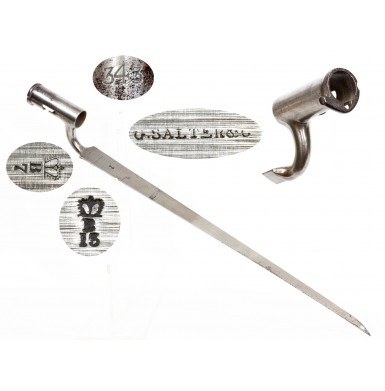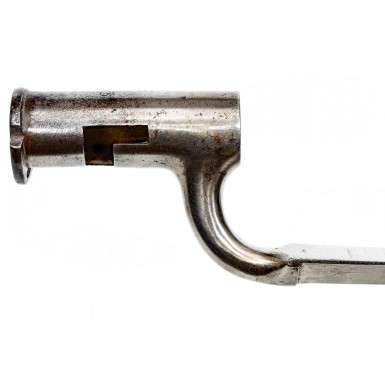British Pattern 1851 Minié Rifle Socket Bayonet - Rare
- Product Code: EWB-2557-SOLD
- Availability: Out Of Stock
-
$1.00
The Pattern 1851 Minié Rifles performed fairly well in the Crimea but were quickly supplanted by the newly adopted Pattern 1853 “Enfield” Rifle Musket. This gun was a major advance in infantry long arm design and featured a reduced caliber bore of .577, a more advanced rear sight and a barrel secured by clamping barrel bands, instead of the P1851’s wedges. The P1851 was so quickly replaced by the new technology of the “Enfield” that at the conclusion of the Crimean War the guns were considered completely obsolete. The hierarchy of the British military expected long arms to have a useable service life of 10 years and required even obsolete weapons to be held in reserve for emergency issue for at least that long before being offered for sale. The Pattern 1851 Minié Rifle was held in such low regard after the adoption of the P1853 that the many of the guns were “stored” outside, exposed to the weather in an area adjacent to the Tower of London known simply as “the ditch”. More than likely this “storage area” was in fact the old moat that surrounded the Tower in earlier days, and it appears that due to a poorly managed and somewhat corrupt ordnance supply system, much of the surplus materiel from the war in the Crimea suffered a similar fate.
With the coming of the American Civil War, and the urgent need for infantry long arms by both sides, a large number of obsolete British arms were sold as surplus, most of which were sold to the Confederacy by S. Isaac, Campbell & Company. According to Confederate purchasing records, some 14,900 British Pattern 1851 Minié Rifles were purchased during the early days of the war. Most of these arms were purchased between August of 1861 and January of 1862, with a handful purchased in the summer of 1862. Records indicate that at least 10,000 of these arms (and probably all of them) were purchased from J.E. Barnett & Sons of London, who had acquired the guns from the British Ordnance Department. Due to the fact that the arms had been left exposed to the elements in the Tower ditch for several years, Barnett refurbished the guns to make them functional. This apparently included the replacement of worn, damaged or missing parts and also involved re-proving the guns at the London Proof House. It is also likely that bayonets had to be contracted for to provide with the guns, as many of the bayonets were no doubt missing, damaged or unserviceable due to exposure to the weather. All known examples of Confederate imported Pattern 1851 Minié Rifles show a set of London commercial proofs, applied during the Barnett refurbishment process, in addition to their original British military proofs, or their remnants. Barnett sold the majority of these arms to S. Isaac & Campbell at a rate of 40 shillings each, including the socket bayonet, and the Confederacy was charged 44 shillings, a simply 10% mark up for handling the sale. The summer of 1862 purchases were sold to the Confederacy at the lower rate of 40 shillings each. The guns were inspected by Messrs. Curtis and Hughes, who had been hired by S. Isaac & Campbell to act as viewers of arms. The P1851s inspected by Curtis & Hughes bear the inspection mark of CH / 1 in a small circle, on the upper comb of the stock, forward of the buttplate tang. Confederate documents refer to the Pattern 1851 rifle muskets by a number of different names, including “Old Army Pattern, rifled,” “Second-Hand Government Rifles,” “Minié Rifles,” “Second-Hand Rifles 1851 Pattern,” “Brown Bess Rifles 1851 Pattern” and “Rifled Brown Bessies.” Pattern 1851 Rifle Muskets were arriving in Confederate ports no later than January of 1862, with deliveries continuing throughout most of that year. According to the McRae Papers, P1851s were included in the cargos of the blockade runners Gladiator, Harriett Pinckney, Southwick,Stephen Hart and Ella Warley. While the guns that were aboard the Ella Warley and Stephen Hart (some 3,520 guns) were lost to capture by the Federal blockading squadron, 11,380 Pattern 1851 Minié Rifles were successfully delivered to Confederate ports and were subsequently issued for service. These guns had already seen hard use in the Crimea and saw additional hard service in Confederate hands. The end result is that the Pattern 1851 Minié Rifle is now a rarely encountered weapon and to my knowledge, only about twenty Confederate marked P1851s are known to exist today.
The only item related to the Pattern 1851 Minié Rifle that is scarcer on the market than the gun itself is its accompanying socket bayonet; the Pattern 1851 Socket Bayonet. The standard P1851 bayonet was an adaptation of the British Pattern 1842 Socket Bayonet that had been in use with the British military previously. Only two dimensional changes were made to the new P1851 bayonet when compared to the earlier P1842. First, the muzzle diameter of the new bayonet was reduced to .87” from .945”. This was a result of the reduced .708” caliber of the P1851 versus the earlier .75” caliber bore of the P1842. Secondly, the muzzle to stud distance was reduced on the new P1851 bayonet because the P1851’s front sight was placed closer to the muzzle than the bayonet stud was on the P1842. This new distance was only 1.2”, versus the earlier 1.6”. Otherwise the bayonets are visually nearly identical with an overall length of 21”, an 18” triangular blade and a 3” socket with a three step mortise and no locking ring. The bayonet was secured by an eccentric ridge on the rear edge of the socket that engaged the Lovell bayonet catch under the muzzle of the musket. Like most British socket bayonets of the period the construction was of a combination of iron and steel with the iron socket and neck blued and the steel blade left bright.
The first 18,000 P1851 bayonets were actually modified from existing stocks of P1842 bayonets by having their sockets shrunk by a process of heating and cooling and having the third step of the bayonet’s mortise cut an additional .4” to get the right muzzle to stud distance. Additional bayonets were supplied by the various British Ordnance Department contractors in Birmingham, as none of the bayonets were produced at Enfield. British military examples were inspected, typically with a {CROWN}/B/7. Those bayonets produced for commercial sale were not inspected. For whatever reason, the survival rate of these bayonets is extremely low. Over the last two decades while I have had the opportunity to own and sell several P1851s, but this is only the third P1851 bayonet I have ever had the opportunity to offer for sale, and the other two were actually the same bayonet that I sold twice, several years apart!
Offered here is a FINE condition example of a scarce Pattern 1851 Minié Rifle Socket Bayonet. The bayonet is a rare British military inspected example and is marked by the contractor who delivered the bayonet, G. SALTER & CO. The blade is War Department inspected on its face at the shank junction with the expected {CROWN}/B/7. An additional inspection mark {CROWN}/B/16 is present about 2” from the face of the shank. The rack or mating number 343 are stamped into the top of the socket. The Salter maker mark is located across the face of the blade, about 1.5” from the shank face.
George Salter & Company was a Birmingham manufacturer of spring steel and balances (scales) that was started in 1760 by Richard & William Salter. Upon their deaths John & George Salter took over the business and by the 1790s they had become one of the leading employers in West Bromwich (about 5 miles NW of Birmingham), continuing to manufacture springs and balances, and adding bayonets to their manufacturing capacity. For the next 200 years the company continued in business under the name of George Slater, and during the late 18th Century and 19th Century they were one of the premier bayonet makers to produce bayonets for the British Board of Ordnance (later War Department), as well as the commercial and export trade – especially to the North & South during the course of the American Civil War. During the latter part of the 19th Century, Salter returned to their original specialty and continued to expand their spring steel, spring and weighing and balance business. Salter actually continues to do business today as a subsidiary of Avery Weigh-Tronix, who acquired Salter in 2000.
Salter was one of the seven original contractors that were selected to produce the first Pattern 1851 socket bayonets. Initially Heighington & Co was contracted to deliver 10,000 bayonets at the contract price of £2.6, to be delivered at 1,000 per week. Apparently, they were unable to deliver as promised, so the contract was broken up among Heighington and six other contractors, including Salter. Salter’s initial contract was for 1,666 bayonets and was dated January 5, 1852. On May 28 they received a second contract for 2,609. On September 8 they received their third contract for 350 bayonets, delivering a total of 4,625 out of some 30,081 P1851 bayonets contracted for by the War Department between January 1852 and April 1855. As such, Salter bayonets represent only about 15% of the total P1851 bayonet production for the British military.
As noted, the bayonet is in FINE condition and remains quite crisp. The socket and shank retain about none of their original blue, but some hits are present on the reinforcing ring and eccentric Lovell catch, in the form of an oxidized plum brown patina. There is more scattered surface oxidation and discoloration scattered over the entire socket. The 3” socket remains in fine, crisp condition with no real pitting and both ends of the socket remaining perfectly round. The muzzle diameter measures .88” and the muzzle to stud distance measures 1.23”. The blade has a medium pewter gray patina and shows some very small scattered flecks of pinpricking on its face, as well as scattered freckles of darker oxidation, discoloration and age staining here and there. The bayonet blade is full-length with an 18” blade, measured from the face of the shank, and remains quite sharp at the tip. The markings on the blade remain very clear and legible and some original horizontal manufacturing tool and polishing marks are present along the first 4.5” of the blade, where the cross polish is evident on mint condition examples.
Overall this is a wonderful example of a very scarce British Pattern 1851 Minié Rifle Socket Bayonet by marked by George Salter & Co and quite likely imported along with the nearly 15,000 refurbished British military Pattern 1851 Minié Rifles that were purchased by the Confederacy. This is an extremely rare bayonet that is rarely found for sale and it would be a fantastic addition to the display of your Pattern 1851 Minié Rifle, whether it is a British military one or a Confederate imported example.
SOLD
Tags: British, Pattern, 1851, Minié, Rifle, Socket, Bayonet, Rare






